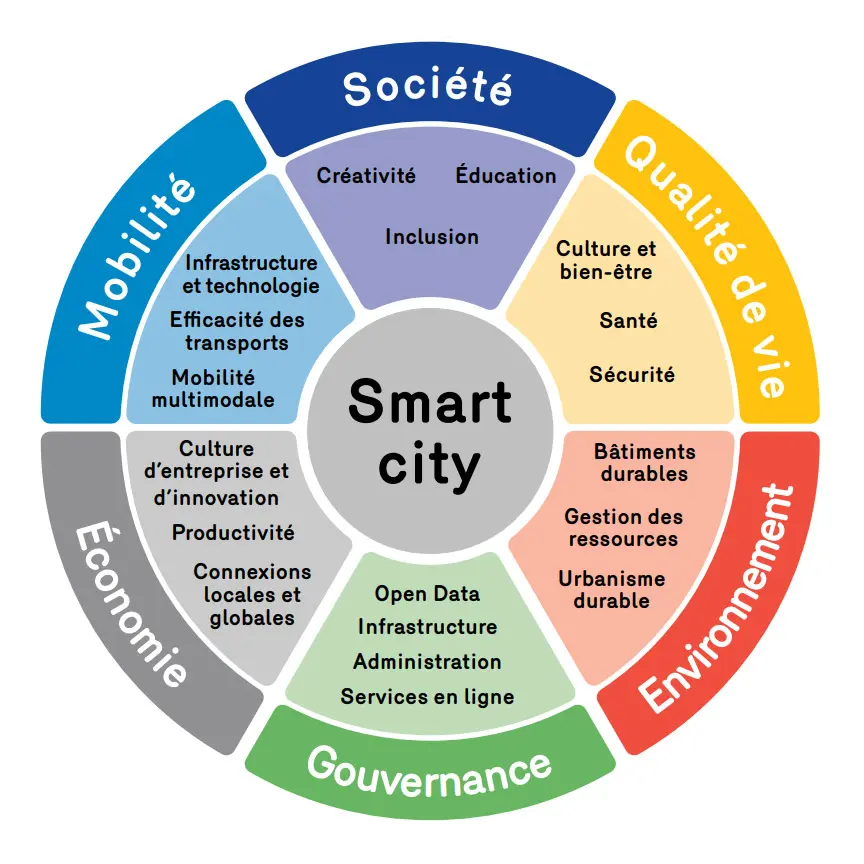The Brussels Smart City strategy
The aim for Brussels Smart City is to have a measurable impact on all indicators which define quality of life, for both citizens and businesses. Potential smart solutions will, among other things, be chosen for how they help to improve the performance of these indicators.
The achievement of this aim is based on six pillars which represent the six policy fields identified by Brussels Smart City. Each of them comprises projects which, through their progressive implementation in Brussels, will make it possible to achieve the aim.
These pillars are based on basic elements or catalysts for a ‘Smart City’. The basic elements (data, technologies, governance, cooperation and human capital) are the necessary conditions for project implementation.
Smart City Office
An important part in the implementation of and follow-up for the Smart City policy in the Brussels-Capital Region is played by Smart City Office, which thus takes on the role of leader.
Smart City Office will be responsible for:
- acting as the first point of contact for answering questions and disseminating information on the Smart City policy of the Brussels Region;
- acting as a centre of knowledge and expertise through which to optimise the acquisition and sharing of knowledge and expertise with all stakeholders in the Quad Helix, through workshops, round tables, regular publications, etc. It also acts as an adviser to the public authorities and government for Smart City Brussels;
- developing a network which will allow the regular meeting of those responsible for Smart City policy within the public administrations in order to promote cooperation and transparency around ‘smart’ initiatives;
- actively encouraging the various administrative authorities to work together, look for synergy and, where necessary, take measures to ensure such cooperation. For instance, appropriate projects will be selected, supported and monitored by Smart City Office;
- ensuring that the Smart City policy objectives are monitored.
The Brussels-Capital Region’s definition of the smart city
For the Brussels-Capital Region, ‘A Smart City is a city which uses smart solutions, based on data and certain technologies, which can lead to improved quality of life in a region’.
Each word of this definition implies key concepts which call for clarification:
Smart solutions
The difference between ‘traditional’ solutions and ‘smart’ solutions lies in the new technologies which the latter exploit. For instance, the deployment of a Smart City depends on the existence and development of a reliable and evolving infrastructure comprising, among other things, data sensors, broadband and wireless networks, databases and data centers, end user equipment, such as smartphones, tablets, laptops, etc. All these elements together, or even their combination, allow solutions to become smart, such as those conceptualized in the definition of a Smart City.
Data
The second key concept of this definition is data. Data are a primary resource for any Smart City, fueling smart solutions.
A large quantity of data is already generated in Brussels through existing installations, via sensors and detectors measuring traffic flow, for example, or via surveillance cameras.
A Smart City is said to be ‘data driven’, which means that it is ‘oriented around data’. For instance, decisions, changes or municipal intervention are mainly based on the analysis of data and not on the intuition or past experience of decision-makers.
These data must be reliable and of high quality. They must also be described in a structured, formatted manner in order to be analysed and understood by information systems. They must also be standardised so that the various IT systems can understand each other (principle of interoperability). Lastly, and above all, they must be secured through their entire life cycle.
The public services in Brussels are starting to appreciate the importance of data, as reflected for example, in the implementation of the ‘open data’ policy and of the ‘only once’ principle.
Quality of life
The main objective of a Smart City is to improve the quality of life of citizens and businesses. This idea is based on the capacity of a city to meet all the economic, social and environmental challenges confronting it. For our Region, based on existing strategic documents, the challenges relate to demographic expansion, sustainability and respect for the environment, mobility, economic development, employment, training and education and, lastly, the fight against a two-speed city and poverty.
Technologies are not an end in themselves, but rather a tool in the design of the smart city of the Brussels-Capital Region. The digital transition underpins these objectives to create added value for the people of Brussels, both citizens and entrepreneurs. Data play a central role in this.
Finally, Brussels Smart City adopts the model of an integrated city:
- the smart city relies on the involvement and interactions of four categories of players: the public services, citizens, businesses and the academic world (teaching, research), according to the ‘Quad Helix’ principle;
- the smart city is built according to a cross-functional logic: it integrates all dimensions of public action, regardless of which authority (local, regional, community, federal) is responsible for it.
In concrete terms, the Brussels-Capital Region considers the smart city as an innovation and local participation platform where the public sector, the academic world, private interests and citizens can meet and engage in an exchange to generate new value and cooperate and create together. External linkParadigm contributes to this model through its platforms pooling ICTs for public services.
6 key words to understand the smart city
Smart cities want to meet many urban challenges: the environment, good governance, mobility, prosperity, the growing population (or its ageing), etc. A few key words summarise how smart city projects are addressing these challenges:
- Collaborate: in the smart city, public services operate in an open environment. They exchange their data and share their projects to make services more efficient and more effective, focused on the users, while creating economies of scale.
- Save: the smart city thinks in a sustainable way and therefore saves energy, water, raw materials, food and financial resources to continue to prosper in an era of transition while reducing its polluting emissions.
- Innovate: the smart city must encourage its citizens, its businesses and public services to come up with new ways of organisation, sharing, communicating, producing… to develop urban dynamism through innovative services.
- Integrate: the smart city cannot leave anyone behind and must therefore enrich each person’s quality of life, by reducing the social divisions of education, gender, health, safety, etc.
- Participate: the smart city is not a real city if it does not associate its citizens, its businesses … with its projects. Nobody can be left on the side lines in the smart city! Participation is key to good governance in the smart city.
- Simplify: smart cities, except for a few rare smart cities created from scratch, all have a past during which regulations or customs have gradually developed… sometimes obsolete, sometimes counterproductive and often out of phase with the simplicity of web-based services.
The 6 action areas of smart cities
To transform itself into a smart city, a city has many areas in which it can act. Six basic directions for action will enable it to direct its objectives along this route, according to the definition of smart cities given by Boyd Cohen, an urban development researcher:
- The smart economy: it is a city that wants to position itself as a capital of the new economy and innovation as well as a centre that draws people to it.
- Smart governance: it is a city whose public services have entered the digital era with efficient online services, wifi and the use of digital data produced in the city.
- The smart environment: it is a city which reconciles its roles as a living space, for mobility, an economic centre… while reducing its footprint on the planet (reduced consumption of energy and natural resources and reduced polluting emissions).
- Smart mobility: it is the city which organises itself to offer an alternative to car congestion and pollution by promoting the effectiveness of means of collective and sustainable travel.
- The smart population: it is a city which fosters the development of its citizens by levelling out inequalities and encouraging them to acquire skills.
- The smart living environment: it is a city which pushes itself up to the highest level in terms of health and safety for example.

The role of technology in smart cities
Smart cities all share the characteristic of acting on their services and activities to make them more efficient. The ways they achieve this are very diverse, but they often have in common to use of digital technology resources (or ICTs, information and communication technologies). The degree of integration of ICTs in the urban functions is sometimes even considered as the criterion that marks out smart cities from other cities.
The smart city can thus be compared to a lasagna where three “layers” of technology overlay each other:
- The lowest layer, digital data, in particular, are the smart city’s raw material, which are continually growing. It is “Big Data” which transforms the data into new services. Whereas Open Data is where these services are supplied with data from the public authorities.
- The middle infrastructure layer brings together all the necessary equipment to make these data available, thanks to sensors (pollution probes or video cameras for example), telecommunications networks (optical fibre, wifi) and data centres (where the data are stored).
- The software is the top, smart layer, the one which creates information from the data, such as a mobile application cross-referencing public transport timetables, locating a bus in traffic or that of a smartphone used to inform the user when their bus will arrive.
Latest news


Paradigm launches a new version of Datastore, the open data portal for the Brussels Region
Datastore, the regional open data platform, has been given a makeover. More readable, more intuitive, more accessible:...

MyAccess becomes a Regional Digital Solution!
The MyAccess platform, providing secure access to digital services, was recently awarded the status of Regional Digital...

Paradigm: the first winner of the Smart City Challenge 2024 with the TreeCity project
Cracked roadways, lifting pavements, conflicting underground land use juggling technical networks and tree roots......

Paradigm gives its users a voice: feedback on the eSign Users Club
On Thursday 19 June, on the 32nd floor of the IRIS Tower, with a breathtaking view of the Brussels region, Paradigm...